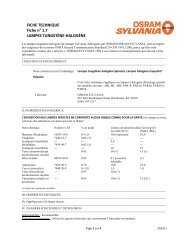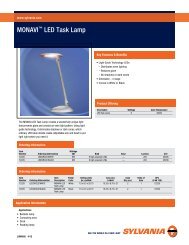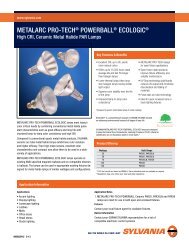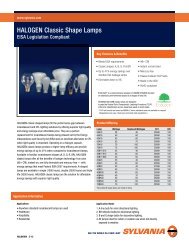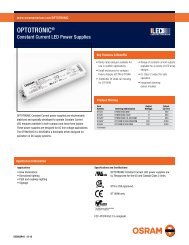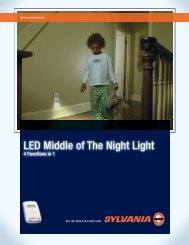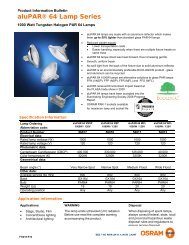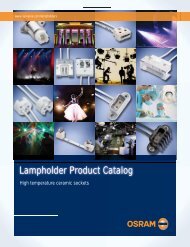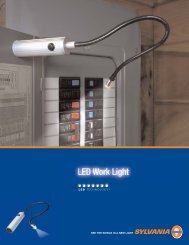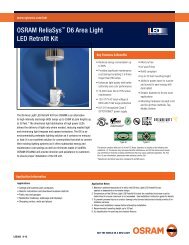lighting control for the smart building addressable ... - Osram Sylvania
lighting control for the smart building addressable ... - Osram Sylvania
lighting control for the smart building addressable ... - Osram Sylvania
- No tags were found...
Create successful ePaper yourself
Turn your PDF publications into a flip-book with our unique Google optimized e-Paper software.
L I G H T I N G C O N T R O L F O R T H E S M A R T B U I L D I N GECS:ADDRESSABLE LIGHTING CONTROL ANDENERGY MANAGEMENT SYSTEM
TAKE CONTROL OF YOUR LIGHTING ENERGY COSTSECS:The Energy Control System, is <strong>the</strong> world’s first intelligent<strong>addressable</strong> <strong>lighting</strong> <strong>control</strong> system designed with4 underlying philosophies in mind:> Extraordinary energy savings> Optimized <strong>lighting</strong> quality and workplace ergonomics> Simplicity of design, installation and use> Immediate return on investmentECS was designed from <strong>the</strong> ground up as anintegrated <strong>lighting</strong> <strong>control</strong> and energy managementsystem that delivers <strong>the</strong> shortest possible paybackfrom energy savings while at <strong>the</strong> same timeimproving <strong>lighting</strong> quality and personal <strong>lighting</strong>com<strong>for</strong>t. Addressable fixture level dimming andswitching <strong>control</strong>s coupled with easy to use <strong>control</strong>software allow ECS to respond dynamically to <strong>the</strong>ever changing characteristics of a <strong>building</strong> by alwaysproviding <strong>the</strong> right amount of light when and whererequired. By integrating and simultaneouslyemploying six different energy managementstrategies in one seamless system, ECS virtuallyeliminates wasted energy from <strong>lighting</strong>.> VARIABLE LOAD SHEDDING.> TASK TUNING>DAYLECS puts ultimate <strong>control</strong> of <strong>lighting</strong> at a facilitymanager’s finger tips through <strong>the</strong> simple click of amouse. Lighting now truly becomes a “<strong>control</strong>lable”energy load enabling facilities to incorporate <strong>lighting</strong>as part of a portfolio wide energy managementstrategy. Explore <strong>the</strong> power of ECS and learn how totake <strong>control</strong> of your <strong>lighting</strong> energy costs.> PERSONAL CONTROL
HOW CAN YOU BENEFIT FROM THE POWER OF ECS?Reduce <strong>lighting</strong> energy costs by 50% to 75% resulting inlower <strong>building</strong> operating costs, improved cash flow and enhanced<strong>building</strong> value.Improve workplace ergonomics, occupant productivityand tenant satisfaction by optimizing <strong>lighting</strong> quality andproviding individuals with <strong>the</strong> ability to <strong>control</strong> <strong>the</strong>ir workenvironment through ECS’s personal <strong>control</strong> feature.Promote your <strong>building</strong>’s “Green” image and enhanceyour ability to achieve LEED certification. The EnceliumECS solution contributes between 12 and 22 points to LEEDcertification, depending on <strong>the</strong> specific application and o<strong>the</strong>r factors.Encelium ECS will contribute in four of <strong>the</strong> six LEED categories,including sustainable sites, energy, indoor environmental quality andinnovation in design.Comply with Building Codes and Energy EfficiencyIncentives. ECS facilitates compliance with Title 24, ASHRAE 90.1,EPACT and various utility rebate programs.Dynamically adapt your <strong>lighting</strong> system to changing<strong>building</strong> uses. Changes to workspace use, varying <strong>lighting</strong>requirements or reconstruction can easily be addressed through ECS’s<strong>control</strong> software without ever having to physically alter wiring ormove hardware.Use <strong>lighting</strong> <strong>control</strong> as <strong>the</strong> cornerstone of a facilitywide energy management strategy. With <strong>the</strong> ability to shed<strong>lighting</strong> load dynamically, ECS can be used <strong>for</strong> energy peak shaving ordemand response strategies. ECS can also integrate with <strong>building</strong>automation and energy management systems.> OCCUPANCY CONTROLIGHT HARVESTING> SMART TIME SCHEDULING
POINT, CLICK, CONTROL, SAVE.LIGHTING CONTROL MADE SIMPLESIMPLE TO DESIGN/SPECIFY: ECS utilizes a universal interface module that connects to standard <strong>lighting</strong> components such aslow voltage dimming and non-dimming ballasts, occupancy sensors or photo sensors. Software based zone configuration is independentof <strong>lighting</strong> circuits or switch legs making design and specification simple and virtually error free.SIMPLE TO INSTALL : Interface modules can be installed in a daisy chain wiring topology utilizing pre-fabricated Cat. 3 cable withRJ45 connectors. Connection to a fixture or sensor is as easy as “click and go” <strong>for</strong> <strong>the</strong> installer with no pre-addressing required.SIMPLE TO USE : Central <strong>control</strong> software enables facility managers to <strong>control</strong> each fixture in a <strong>building</strong> ei<strong>the</strong>r from <strong>the</strong>irdesktop PC or remotely via <strong>the</strong> Internet. Easy to use floor-plan based software allows <strong>for</strong> simple navigation or system configuration.SIMPLE TO ADAPT: Since each light fixture and sensor in a <strong>building</strong> is <strong>control</strong>led individually, system reconfiguration due tochanges in workspace use or tenant construction is done entirely through ECS software. Association of fixtures to zones can bechanged by a simple “drag and drop” without ever having to physically re-wire or move hardware again.
MAXIMIZE ENERGY SAVINGS:SIX STRATEGIES FOR LIGHTING CONTROLECS is <strong>the</strong> only <strong>lighting</strong> <strong>control</strong> system that simultaneously employs six different energy management strategies on a facility wide basis torealize maximum energy savings. These strategies work interdependently and are cumulative in <strong>the</strong>ir effect on overall <strong>building</strong> energysavings. The graphs below illustrate typical energy savings from each of <strong>the</strong>se strategies in a given space.SMART TIME SCHEDULING. In areas of a <strong>building</strong> where occupancy <strong>control</strong> is not appropriate,time scheduled switching or dimming of lights can be employed <strong>for</strong> zones as small as a room or evenkW10-50%individual light fixture.6:00 am 6:00 pmDAYLIGHT HARVESTING. Through <strong>the</strong> use of photo sensors, light levels are automatically adjustedto take into account ambient natural sunlight. Appropriate light levels are maintained and artificialkW17%<strong>lighting</strong> is dimmed when necessary.6:00 am 6:00 pmTASK TUNING. Setting default (maximum) light levels to suit <strong>the</strong> particular task or use of akW28%workspace in order to eliminate over <strong>lighting</strong>.6:00 am 6:00 pmOCCUPANCY CONTROL. Through <strong>the</strong> use of occupancy sensors, lights are automatically turnedkW35%on or off or dimmed based on occupancy detection.6:00 am 6:00 pmPERSONAL CONTROL. Through <strong>the</strong> Personal Control Software, individuals can <strong>control</strong> (dim) <strong>the</strong>light levels in <strong>the</strong>ir workspace to suit <strong>the</strong>ir personal preferences from <strong>the</strong>ir desktop PC.kW38%6:00 am 6:00 pmVARIABLE LOAD SHEDDING. The automatic reduction of electrical demand in a <strong>building</strong> byshedding <strong>lighting</strong> loads dynamically (through dimming or switching) ei<strong>the</strong>r to shave peak demand orkW10%reduce energy consumption. Load shedding can be done selectively by lowest priority areas first.6:00 am 6:00 pmCOMBINED ENERGY SAVINGS. Potential cumulative savings from above strategies.kW71-79%combinedCONTRIBUTION OF SIX STRATEGIES TO ENERGY SAVINGSThe graph on <strong>the</strong> right illustrates how each of <strong>the</strong>se 6 strategiescontribute to overall <strong>building</strong> energy savings and <strong>the</strong> combined impacton <strong>lighting</strong> energy consumption (actual results taken from an Enceliumretrofit project – Toronto, Canada).kVA12108Pre-RetrofitTASK TUNING6PERSONAL CONTROL4Post-RetrofitSMART TIME SCHEDULING2OCCUPANCY CONTROLDAYLIGHT HARVESTINGVARIABLE LOAD SHEDDING01:00hours5:0010:0015:0019:0023:000:00Colored areas between <strong>the</strong> respective load profiles (Pre-retrofit and Post-retrofit) represent typical energysavings from each strategy over a 24 hour period, averaged over 1 hour intervals.
REDEFINING LIGHTING CONTROLWhen we started Encelium we wanted to define our business as being small enough to innovate but big enough to fundamentally“change <strong>the</strong> game”. Lighting <strong>control</strong> technologies have historically lagged behind o<strong>the</strong>r automated <strong>building</strong> <strong>control</strong> systems eventhough <strong>lighting</strong> often represents <strong>the</strong> single largest energy load in most commercial <strong>building</strong>s. By starting with many years of <strong>lighting</strong>and <strong>control</strong> system experience, a clean sheet of paper and no legacy systems to design around, we believe that we have achieved ourgoal of “changing <strong>the</strong> game” with <strong>the</strong> introduction of <strong>the</strong> Energy Control System (ECS).Conventional ef<strong>for</strong>ts to <strong>control</strong> <strong>lighting</strong> <strong>for</strong> <strong>the</strong> purpose of energy management have generally been restricted to switching lights on andoff using ei<strong>the</strong>r occupancy sensors or relay based <strong>lighting</strong> panels. These are one dimensional strategies that do not take into accountfactors such as available natural sunlight, divergent and changing <strong>building</strong> uses and personal <strong>lighting</strong> preferences of occupants letalone <strong>the</strong> specific energy requirements of <strong>the</strong> <strong>building</strong>. ECS takes a holistic approach to <strong>control</strong>ling <strong>lighting</strong> by utilizing every energymanagement measure possible to deliver ultimate savings but never at <strong>the</strong> expense of <strong>lighting</strong> quality. Occupant com<strong>for</strong>t and personal<strong>lighting</strong> preferences are always paramount in <strong>the</strong> ECS decision making hierarchy. With ECS, occupants have <strong>control</strong> of <strong>the</strong>ir own workenvironment, facility managers can <strong>control</strong> every facet of <strong>the</strong>ir <strong>lighting</strong> system and energy managers can <strong>control</strong> <strong>lighting</strong> as part of afacility wide energy management strategy.Advanced <strong>lighting</strong> <strong>control</strong>s represent <strong>the</strong> next generation of <strong>lighting</strong> efficiency technology and Encelium is committed to remaining at<strong>the</strong> <strong>for</strong>efront of this technological revolution. Encelium is also an active player in <strong>the</strong> exploding sustainable <strong>building</strong> technologymarketplace and will continue to promote an environmentally responsible approach to <strong>building</strong> design. We invite you to contact ourrapidly growing international network of distributors, systems integrators and sales representatives and learn more about how ECS trulyredefines <strong>lighting</strong> <strong>control</strong>.Picture below: The Toronto General Hospital realized a 74% energy savingsfrom <strong>lighting</strong> using ECS in <strong>the</strong> R. Fraser Elliott Building in Toronto, Canada.LMS001 4/11Available from:OSRAM SYLVANIA100 Endicott StreetDanvers, MA 01923 USA1-800-LIGHTBULBwww.sylvania.com/<strong>control</strong>s



